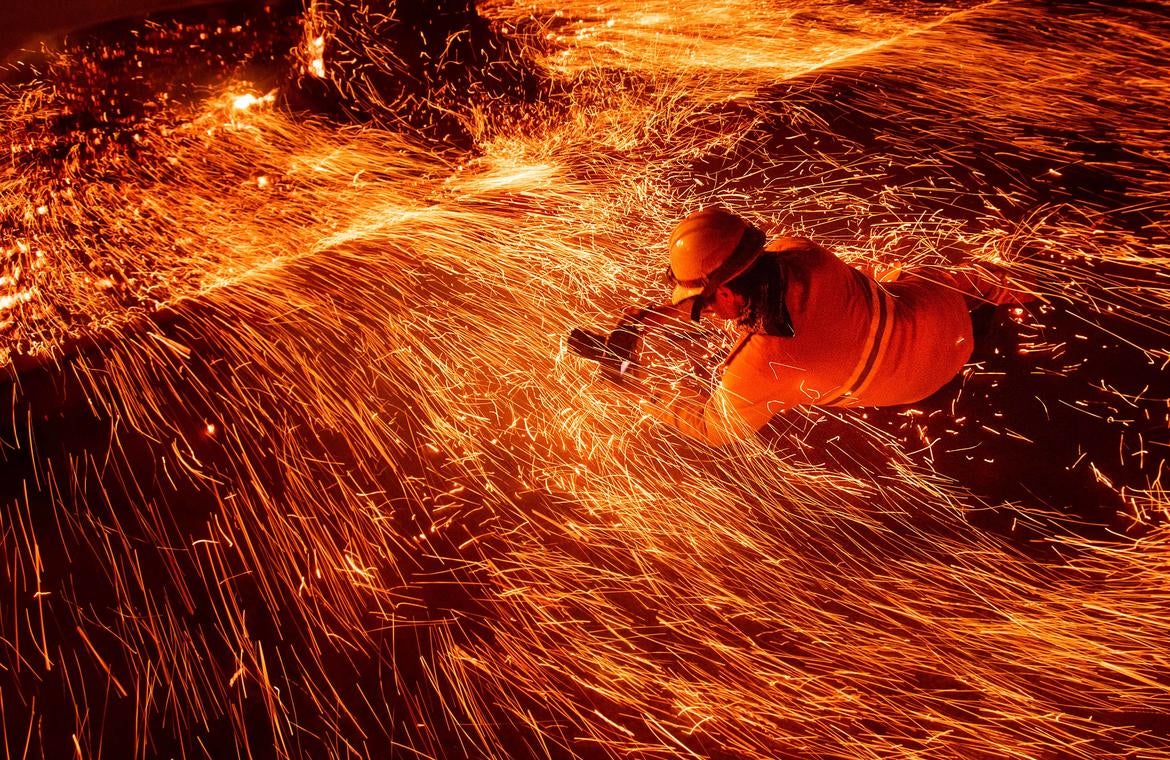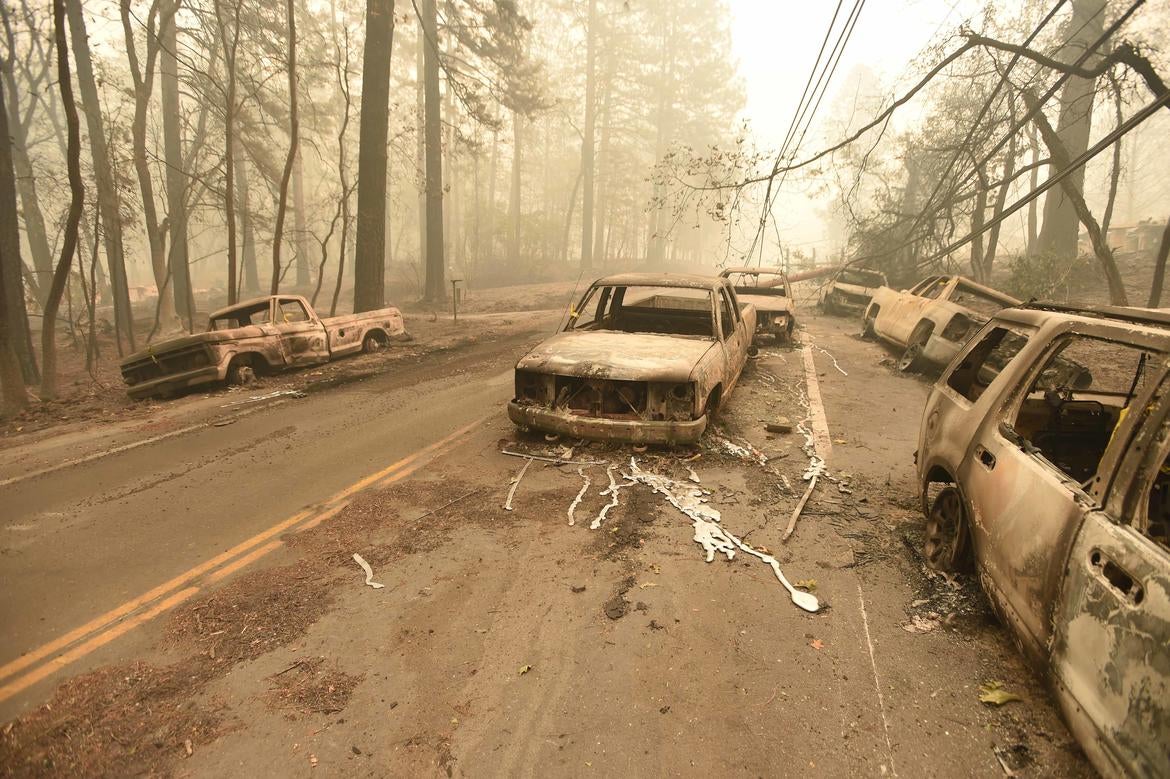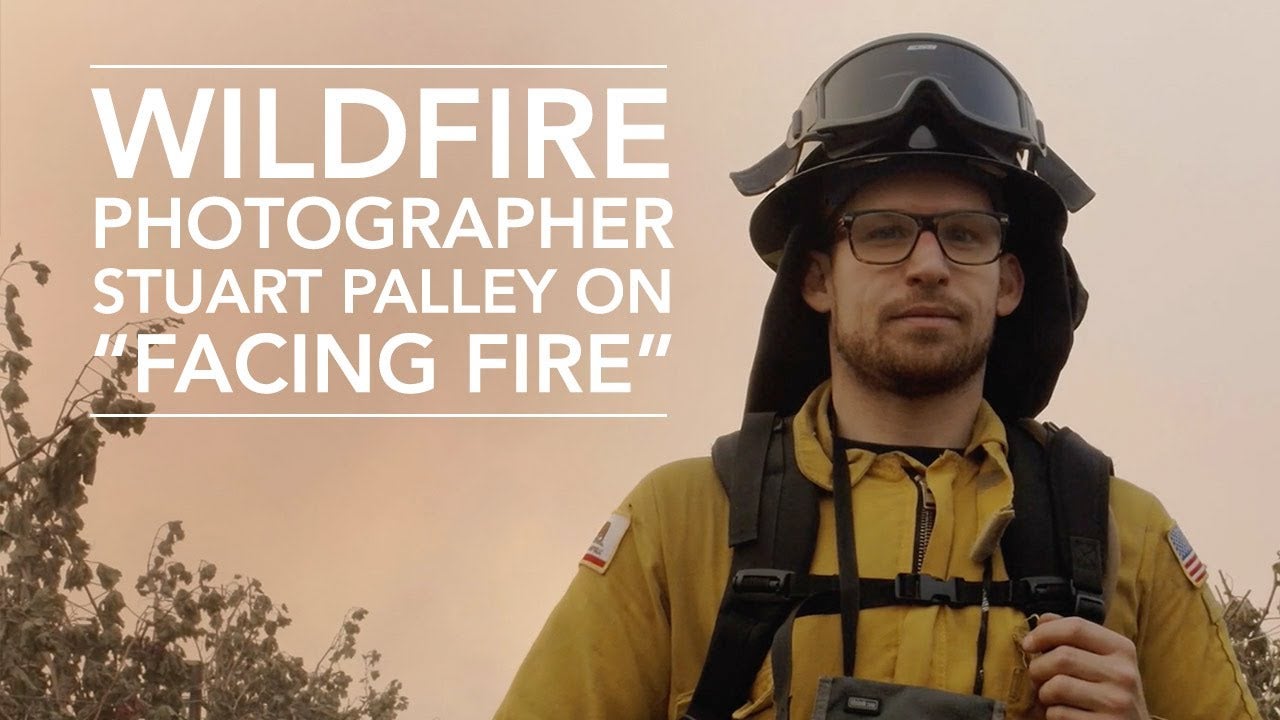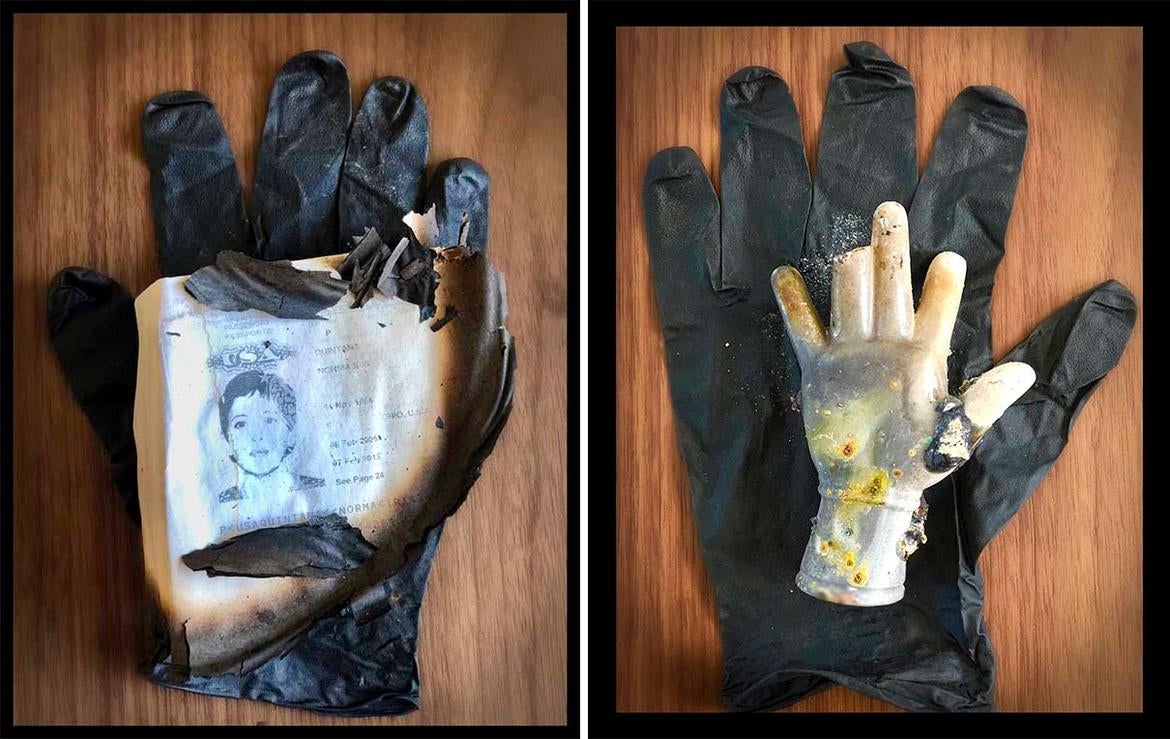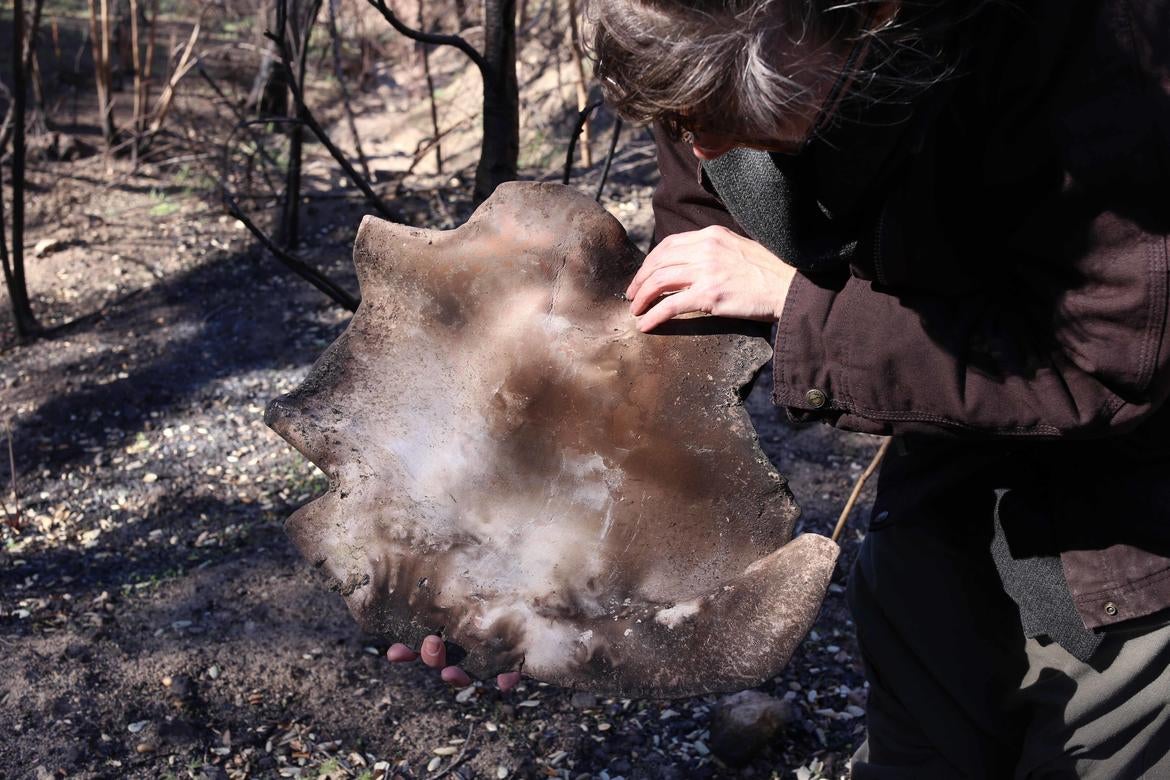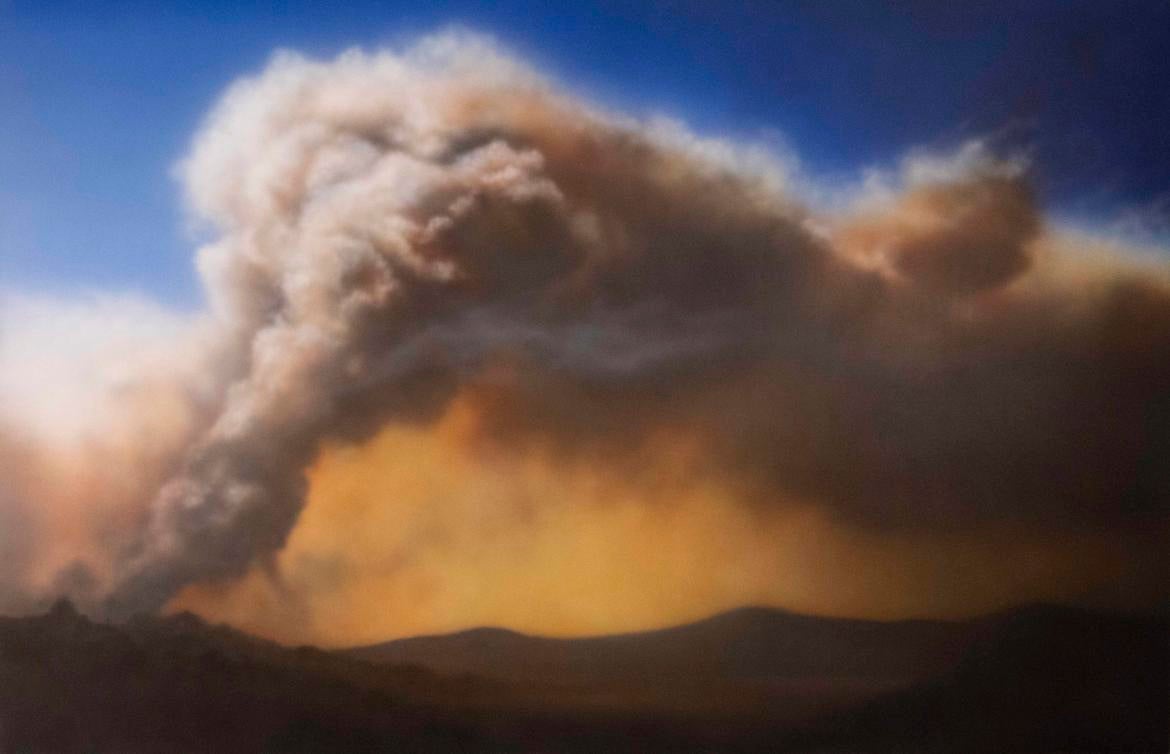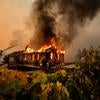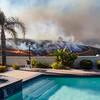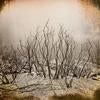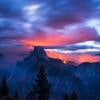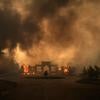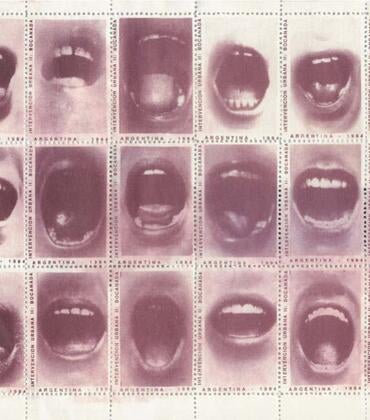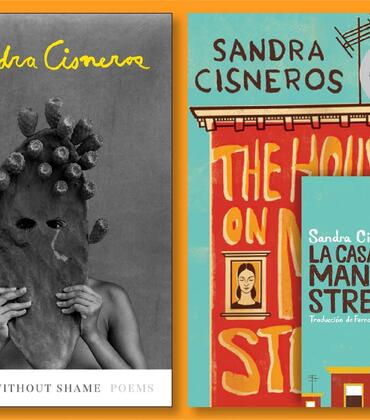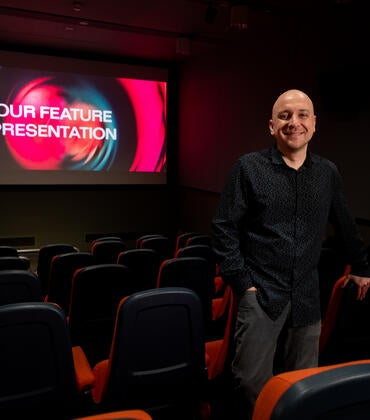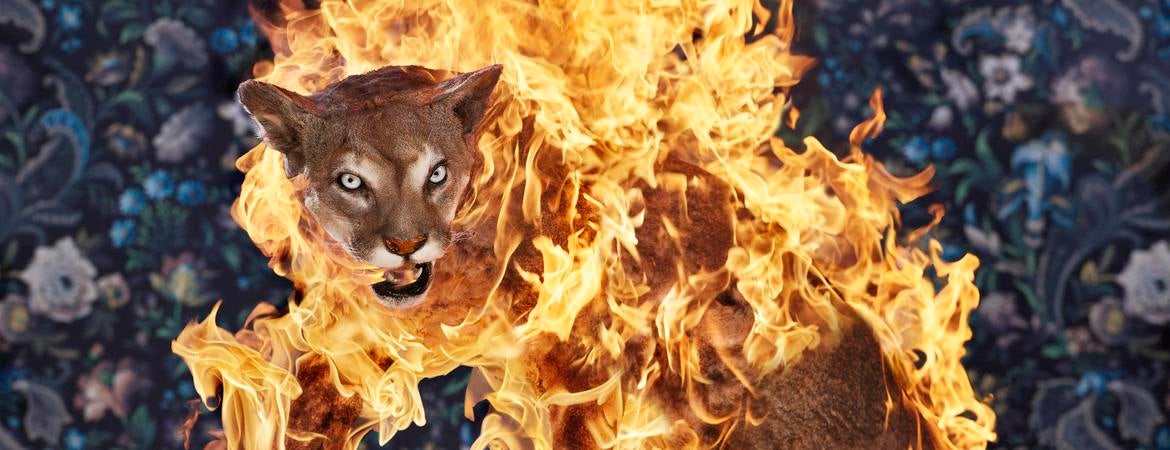
California residents are acutely familiar with wildfires. Blazes of increasing scale, severity, and destructiveness burn across the state throughout longer and longer fire seasons. Sixteen of the 20 largest fires in California history occurred in the last two decades — six in the 18-month span ending August 2019. Those six fires burned 3.65 million acres, destroyed 26,634 structures, and killed 137 people.
A new exhibition at the California Museum of Photography takes a close look at California wildfires and the environmental, climatological, and philosophical implications of living where the threat of fire continues to grow. “Facing Fire: Art, Wildfire, and the End of Nature in the New West,” opening Feb. 22, features work by some of California’s top wildfire photographers and artists whose work is intimately connected to fire.
“In California, fire is omnipresent,” said exhibition curator Douglas McCulloh. “We live in an ecosystem built to burn — and burn explosively. But beyond that, fire carries layers of meaning. It’s mankind’s central metaphor. Fire is passion and punishment. It’s the spark of inspiration and the blaze of anger, the cooking hearth and the apocalypse. Humanity is linked to fire, and we are deeply fascinated by it.”
Among the wildfire specialists featured is Noah Berger, a news photographer of 25 years whose images of wildfires earned him a 2019 Pulitzer Prize nomination. Shooting the Rim Fire in Yosemite in 2013 fueled his ongoing obsession for documenting fires, which he says, “strip off the mundane layers of life.”
“Just being around that intensity of flame, where nature has gone wild and is combusting all around you, is pretty phenomenal to be part of,” Berger said. “All around you is fire and you’re witnessing these beautiful scenes that are devastating, obviously, but that people don’t really get to see . . . It’s kind of like work parred down to its basic elements of you, a camera, a car, and fire.”
With the thrill comes risk. Berger, along with the other wildfire photographers in the exhibition, has had extensive training and uses the same gear as firefighters. Berger also travels in a pack that often includes Josh Edelson and Justin Sullivan, also featured in the exhibition, traveling in two cars and keeping in contact with radios.
“We are all competitors, we’re not working for the same place, but we’re a team,” he said.
Like Berger, Edelson is a news photographer who was drawn to the excitement of wildfire photography around seven years ago, when there was a marked increase in wildfire severity. For him, natural disasters of all kinds are a subject of fascination.
“I feel like it forces us to renew our sense of humbleness as humans,” Edelson said. “We feel like we’ve mastered our environment, but when a natural disaster happens — something like a wildfire, or an earthquake, or hurricane — it kind of puts things into perspective. It makes us feel small, and we have no choice but to be humbled by its power, and that is exciting for me to be able to witness and capture.”
Edelson also notes California is one of only two states that allow for unrestricted media access to wildfires, which he says is only becoming more important to document as they grow in intensity and areas susceptible to wildfire continue to expand as the climate changes.
“It gives us an opportunity to provide an intimate view into what’s actually happening within the fire zone,” he said. “The first major fire I covered was the Valley Fire near Middletown and flames basically just blew right through and took out almost the entire town. That was the first time I had ever seen anything like that and there are absolutely some environmental changes that are exacerbating fire conditions. These days we can now expect more catastrophic wildfires that will blow right through towns.”
Stuart Palley has also photographed hundreds of wildfires for news outlets over the last seven years, and like Edelson, attributes the increase in severity to climate change. His fascination with wildfires has extended beyond news documentation, with his long exposure shots of wildfires at night turning into a multi-year art project and book called “Terra Flamma.”
His photography juxtaposes the visually stunning beauty of fire with the ever-growing threat posed by climate change. For Palley, it is important to highlight what he considers a lack of necessary action by political leaders. He points to the recent fires in Australia as an indicator of the far-reaching devastation that’s possible if things continue to go unchecked.
“The fires aren’t going anywhere,” Palley said. “Over the last three years to be specific, we’ve had the largest, deadliest, and most destructive wildfires in modern California history and with the ever-increasing feedback loop from the effects of climate change, fire season is something close to three months longer. It’s become a much bigger issue socially since I started, for better or worse — it’s an important story that I think is important to keep telling.”
Photographer Norma I. Quintana is intimately familiar with the destructive power of wildfire. The artist lost her home and studio of nearly 30 years during Napa’s Atlas Peak fire in 2017, her family forced to flee in mere minutes with almost no warning.
“When we were evacuated, we didn’t actually see a fire in front of us or anything, and then our home was destroyed four hours later,” she said. “We never heard any fire alarms, any helicopters — that’s how fast it was.”
As a means of processing the devastation, Quintana began documenting the charred remnants of her home using only her iPhone, the analog photographer having lost her vast collection of cameras in the fire with most everything else she owned. She said she was “propelled” to sift through the ashes of her life, photographing what remained of precious objects — things like an inexplicably shining silver harlequin pin found in the blackened embers or the single-surviving photo of her children, browned and burned around the edges. She framed the objects against the backdrop of her black latex gloves, somehow finding beauty in their resilience amidst the monumental loss.
“I felt like it made it more real when I would identify with the object, because the object and the artifact held a memory, and so in holding a memory, it held a life; in holding a life, it held story,” she said.
Seventy-six photographs and a display vitrine full of charred, salvaged objects make up “Forage From Fire,” her memorial to the things the fire took.
“The loss is not the things — it’s your home, it’s what it represents,” Quintana said. “In the Western culture, we are both blessed and burdened by our things. What I tell people is just embrace it, surrender to it.”
Artist Anna Mayer’s preoccupation with fire arises from her practice in ceramics, particularly her interest in alternative firing techniques. The former Los Angeles resident would often host pit firings — an ancient form of firing pottery in pits filled with combustible materials — and dreamed of other ways of harnessing fire when the idea of using wildfire occurred to her. In 2008, Mayer left 12 torso-sized undulating clay forms inscribed with various phrases in the hills of Malibu. For a decade,“Fireful of Fear” existed as a conceptual gesture with Mayer sending email updates and annual postcards and creating watercolors imagining what the ceramics might look like once fired and pulled from the earth.
Having launched a long-term piece of land art, she was uncertain her pieces would be fired in her lifetime. But in November 2018, the Woolsey Fire raged through the hillsides burning 96,000 acres, destroying 1,643 structures, killing three people — and firing six of Mayer’s sculptural pieces, of which she recovered four. She said the experience left her shocked, horrified, and surprised.
“I always have to say that I was never rooting for a fire at all, and when the Woolsey Fire happened, it was so intense,” she said. “I think what’s changed is that in that 10 years, wildfires have become this marker of the progression of climate change and global warming and so it’s almost like because of the duration of the project, the world has kind of changed around it, unfortunately for the worse,” she said.
“Facing Fire” also features work by Samantha Fields, whose atmospheric paintings, made with hundreds of layers of vaporized acrylic paint, have an ethereal, photographic quality at a distance, belying human touch. Her paintings of Southern California wildfires referenced from her own photographs are part of a larger series dealing with climate change and disaster, a subject she has long examined through her art.
“In the disaster paintings, I do seek to depict the sublime, the notion that a great and destructive force can also be transcendentally beautiful,” Fields said. “It’s hard not to contemplate your own mortality in the face of a funnel cloud or an advancing wall of flame . . . As a child I thought God would destroy the world, as an adult I realized we didn’t need a deity to destroy the world, we were doing it ourselves.”
Fields recalls the Hudson River School artists, transcendentalists who held themselves responsible for the protection of nature, when thinking about her work. She sees her practice as a bookend to the movement.
“If the transcendental painters of the American West believed we could see God’s greatness in nature, perhaps today they would see God’s wrath in the destructive forces of climate change,” she said. “I am very happy to have my work contextualized with the other artists in this show. This subject is of dire importance, and I hope it sparks many meaningful conversations.”
The exhibition also features the work of Kevin Cooley, Jeff Frost, Luther Gerlach, Christian Houge, Richard Hutter, Christoph Kapeller, Benoit Malphettes, Cody Norris, Justin Sullivan, and Joan Wulf. Collectively, their work tells a comprehensive story of fire, asking viewers to consider the impact of humanity on the environment and what the future holds for a land increasingly at the mercy of nature.
“Every human society has possessed fire, tended it, treasured it,” McCulloh said. “Mankind carries torches and gathers fuel. Hearths brand our earliest caves. But now, in the Anthropocene, in the age of climate change, wildfires represent something new — mankind the meddler, nature unbalanced, alarm, warning, the end of the stable world. And through it all, our fascination with fire continues.”
Exhibition Information
“Facing Fire: Art, Wildfire, and the End of Nature in the New West” is on view at the California Museum of Photography Feb. 22-Aug. 9. A free public reception for “Facing Fire” along with five other UCR ARTS exhibitions will be held Saturday, Feb. 29 from 6-9 p.m. A 130-page exhibition catalog published by Inlandia Institute will also be available for purchase. For more information, visit ucrarts.ucr.edu.
Header Image: Christian Houge, "Puma" from the series "Residence of Impermanence," 2019. (Courtesy of the artist)
